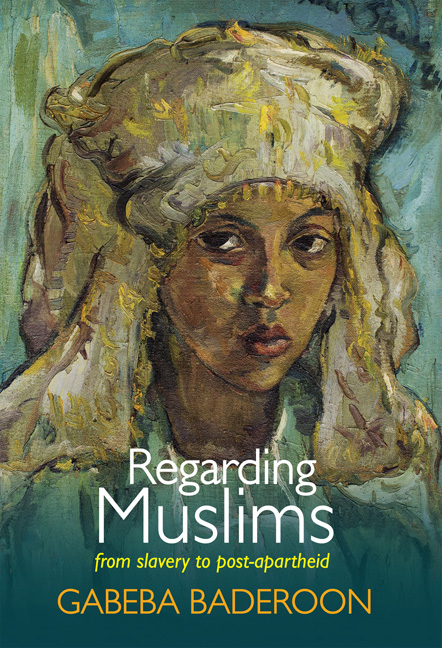Book contents
- Frontmatter
- Contents
- List of illustrations
- Acknowledgements
- Foreword
- Introduction: Beginnings in South Africa
- Chapter 1 Ambiguous Visibility: Muslims and the making of visuality
- Chapter 2 “Kitchen Language”: Muslims and the culture of food
- Chapter 3 “The Sea Inside Us”: Parallel journeys in the African oceans
- Chapter 4 “Sexual Geographies of the Cape”: Slavery, race and sexual violence
- Chapter 5 Regarding Muslims: Pagad, masked men and veiled women
- Chapter 6 “The Trees Sway North-North-East”: Post-apartheid visions of Islam
- Conclusion
- Notes
- Glossary
- Bibliography
- Index
- Plate section
Chapter 1 - Ambiguous Visibility: Muslims and the making of visuality
Published online by Cambridge University Press: 21 April 2018
- Frontmatter
- Contents
- List of illustrations
- Acknowledgements
- Foreword
- Introduction: Beginnings in South Africa
- Chapter 1 Ambiguous Visibility: Muslims and the making of visuality
- Chapter 2 “Kitchen Language”: Muslims and the culture of food
- Chapter 3 “The Sea Inside Us”: Parallel journeys in the African oceans
- Chapter 4 “Sexual Geographies of the Cape”: Slavery, race and sexual violence
- Chapter 5 Regarding Muslims: Pagad, masked men and veiled women
- Chapter 6 “The Trees Sway North-North-East”: Post-apartheid visions of Islam
- Conclusion
- Notes
- Glossary
- Bibliography
- Index
- Plate section
Summary
Africa was not a new world.
– J. M. Coetzee (1988: 2)Regarding the South African landscape
In White Writing, his influential study of landscape in South African literature, J. M. Coetzee argued that European colonists held an ontologically tenuous grasp on the land. For settlers in South Africa, the landscape refused to be blank and inscribable, denying a fantasy of a new Eden. Instead, the African landscape was riven by a stubbornly anterior indigenous presence that transformed colonists in South Africa into belated arrivals – newcomers, temporary, passing. As a consequence, Coetzee observed, they were peculiarly “unsettled settlers” (1988: 8).
This unsettling relationship is encoded in one of the earliest portrayals of the Cape after settlement began: a 1707 copperplate by P. van de Aa titled D'Almeida and his men killed by Hottentots on the shore of Table Bay in 1510. The image depicts a battle at the Cape almost two hundred years before, provoked when Portuguese sailors kidnapped Khoi children and stole cattle during negotiations about provisions (Gordon-Brown 1975: 5). In the resulting battle with Khoisan warriors, the feared Portuguese general Francisco D'Almeida, who had conquered much of the East Coast of Africa, as well as parts of the Indian sub-continent for the Portuguese crown, was killed, along with sixty-four of his sailors. The battle reverberated in the European imperial imagination, creating an association of peril with the Cape that kept the Portuguese from stopping at Table Bay for decades (den Besten 2013: 449). In many ways, therefore, this Dutch image of a Portuguese battle inaugurates a European conception of the South African landscape as perilous and threatening.
The perspective of the engraving is framed by three ships in the lower left corner in the foreground, separated by blustery seas from the shore in the upper right hand corner, where hundreds of Khoisan warriors are gathered, equal in proportion to the ships, brandishing spears and bows against the small figures of five unarmed Portuguese sailors. The print's strongest lines and darkest textures are found in the ships and the formation of Khoisan figures. The ships appear ordered but static, the angles of their masts, sails and flags contrasting with the choppy water. The waves near the ships are heavy and detailed but gradually lose definition and only at the shoreline do the human figures become more distinct.
- Type
- Chapter
- Information
- Regarding Muslimsfrom slavery to post-apartheid, pp. 27 - 45Publisher: Wits University PressPrint publication year: 2014



